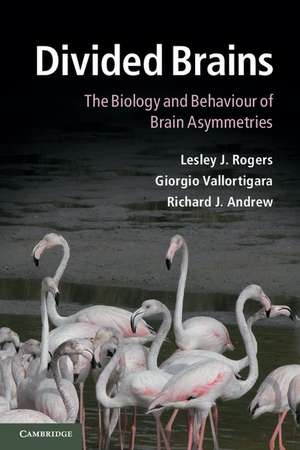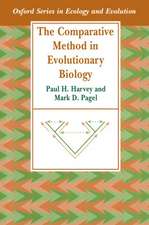Divided Brains: The Biology and Behaviour of Brain Asymmetries
Autor Lesley J. Rogers, Giorgio Vallortigara, Richard J. Andrewen Limba Engleză Paperback – 16 ian 2013
| Toate formatele și edițiile | Preț | Express |
|---|---|---|
| Paperback (1) | 316.34 lei 43-57 zile | |
| Cambridge University Press – 16 ian 2013 | 316.34 lei 43-57 zile | |
| Hardback (1) | 470.09 lei 43-57 zile | |
| Cambridge University Press – 16 ian 2013 | 470.09 lei 43-57 zile |
Preț: 316.34 lei
Nou
Puncte Express: 475
Preț estimativ în valută:
60.53€ • 63.37$ • 50.09£
60.53€ • 63.37$ • 50.09£
Carte tipărită la comandă
Livrare economică 07-21 aprilie
Preluare comenzi: 021 569.72.76
Specificații
ISBN-13: 9780521183048
ISBN-10: 0521183049
Pagini: 234
Ilustrații: 40 b/w illus.
Dimensiuni: 152 x 224 x 11 mm
Greutate: 0.39 kg
Ediția:New.
Editura: Cambridge University Press
Colecția Cambridge University Press
Locul publicării:Cambridge, United Kingdom
ISBN-10: 0521183049
Pagini: 234
Ilustrații: 40 b/w illus.
Dimensiuni: 152 x 224 x 11 mm
Greutate: 0.39 kg
Ediția:New.
Editura: Cambridge University Press
Colecția Cambridge University Press
Locul publicării:Cambridge, United Kingdom
Cuprins
List of illustrations; Preface; 1. Introduction; 2. Function; 3. Evolution; 4. Development; 5. Causation; 6. Applications and future directions; References; Index.
Recenzii
'This fascinating book has been written by three experts in the field. The different roles played by the two sides of the brain were thought to be a uniquely human characteristic, but the authors show that such lateralisation has ancient origins in biological evolution. They have written a superb book which I shall use as an invaluable source for years to come.' Professor Sir Patrick Bateson, University of Cambridge, and co-author of Plasticity, Robustness, Development and Evolution
'Birds do it, bees do it - and so, it seems, do species of every taxa: they show cerebral and behavioral asymmetries that belie the seeming bilateral symmetry of the body, and even the brain itself. Until quite recently such asymmetries, especially in the form of right-handedness and left-brain dominance, were held to be uniquely human, and even to define our species. This anthropocentric view is here comprehensively buried. The book is more than simply a compendium of asymmetries across different species. Rogers, Vallortigara and Andrew cover evolutionary, development and genetic aspects of asymmetry, asking why and how asymmetries evolved in a world that is indifferent to left and right. This is the most in-depth analysis to date, by the three foremost authorities on animal asymmetries, of a phenomenon that has fascinated scientists and philosophers through the centuries.' Michael C. Corballis, University of Auckland
'A timely addition to our understanding of hemisphere difference, this book is a vital and accessible source of information about laterality in fish, reptiles, birds, mammals, and even insects. It does not content itself with merely marshalling information, though it does that very well, but addresses the 'how' and 'why' of the asymmetrical world of all living things.' Iain McGilchrist, author of The Master and his Emissary: The Divided Brain and the Making of the Western World
'It is impossible to do justice to the extraordinarily high quality of this book in the space available here. The authors have produced a monograph of astonishing scope, without sacrifice of rigor. The book is a landmark contribution to comparative neurobiology and cognitive neuroscience. There is no doubt in my mind that it will constitute the gold standard for attempts to synthesize knowledge on animal brain asymmetry for the foreseeable future. This remarkable book will make obsolete the typical introductory psychology textbook, with a single chapter on hemispheric specialization, unrelated to the content of the rest of the book.' Peter F. MacNeilage, Animal Behaviour
'Those who are interested in brain lateralization will find this book, written by eminent brain researchers, to be well written and comprehensive. For others, the striking message is how, once again, comparative research forces us to confront the reality that, although we do have certain capacities that distinguish us from other animals, there are many fewer differences that we can point to as being uniquely human.' Thomas R. Zentall, PsycCRITIQUES
'… elegantly brings together research, especially from the past two decades, on asymmetry (lateralization) of brain structure and function in a wide range of species. I really enjoyed this extremely stimulating and important book and learned a lot about how brains work and how much remains to be discovered about asymmetries and what they mean in a wide variety of species.' Marc Bekoff, Psychology Today
'Divided Brains is relatively trim, well written, comprehensive, and provides the latest information about brain lateralization across the animal spectrum. It is a must-read for scholars interested in brain evolution, including that of humans and their early ancestors.' American Journal of Physical Anthropology
'The text is an important window into how evolution through the development of lateralisation has allowed the brains of a diverse range of organisms to maximise their exploitation of the niches in which they live.' Stephen Hoskins, The Biologist
'… a fascinating and awe-inspiring analysis of cerebral and behavioural asymmetries across the animal kingdom (in both vertebrate and invertebrate species), across experimental techniques and across time both historical and evolutionary. A remarkably charming aspect of this extraordinary book is that, although the authors do not renounce the use of technical terms and definitions to explain principles and functional mechanisms that govern asymmetric brain functions, the language is kept simple and flows very nicely throughout the text, which makes the book suited to a broader audience.' Marcello Siniscalchi, Laterality
'Birds do it, bees do it - and so, it seems, do species of every taxa: they show cerebral and behavioral asymmetries that belie the seeming bilateral symmetry of the body, and even the brain itself. Until quite recently such asymmetries, especially in the form of right-handedness and left-brain dominance, were held to be uniquely human, and even to define our species. This anthropocentric view is here comprehensively buried. The book is more than simply a compendium of asymmetries across different species. Rogers, Vallortigara and Andrew cover evolutionary, development and genetic aspects of asymmetry, asking why and how asymmetries evolved in a world that is indifferent to left and right. This is the most in-depth analysis to date, by the three foremost authorities on animal asymmetries, of a phenomenon that has fascinated scientists and philosophers through the centuries.' Michael C. Corballis, University of Auckland
'A timely addition to our understanding of hemisphere difference, this book is a vital and accessible source of information about laterality in fish, reptiles, birds, mammals, and even insects. It does not content itself with merely marshalling information, though it does that very well, but addresses the 'how' and 'why' of the asymmetrical world of all living things.' Iain McGilchrist, author of The Master and his Emissary: The Divided Brain and the Making of the Western World
'It is impossible to do justice to the extraordinarily high quality of this book in the space available here. The authors have produced a monograph of astonishing scope, without sacrifice of rigor. The book is a landmark contribution to comparative neurobiology and cognitive neuroscience. There is no doubt in my mind that it will constitute the gold standard for attempts to synthesize knowledge on animal brain asymmetry for the foreseeable future. This remarkable book will make obsolete the typical introductory psychology textbook, with a single chapter on hemispheric specialization, unrelated to the content of the rest of the book.' Peter F. MacNeilage, Animal Behaviour
'Those who are interested in brain lateralization will find this book, written by eminent brain researchers, to be well written and comprehensive. For others, the striking message is how, once again, comparative research forces us to confront the reality that, although we do have certain capacities that distinguish us from other animals, there are many fewer differences that we can point to as being uniquely human.' Thomas R. Zentall, PsycCRITIQUES
'… elegantly brings together research, especially from the past two decades, on asymmetry (lateralization) of brain structure and function in a wide range of species. I really enjoyed this extremely stimulating and important book and learned a lot about how brains work and how much remains to be discovered about asymmetries and what they mean in a wide variety of species.' Marc Bekoff, Psychology Today
'Divided Brains is relatively trim, well written, comprehensive, and provides the latest information about brain lateralization across the animal spectrum. It is a must-read for scholars interested in brain evolution, including that of humans and their early ancestors.' American Journal of Physical Anthropology
'The text is an important window into how evolution through the development of lateralisation has allowed the brains of a diverse range of organisms to maximise their exploitation of the niches in which they live.' Stephen Hoskins, The Biologist
'… a fascinating and awe-inspiring analysis of cerebral and behavioural asymmetries across the animal kingdom (in both vertebrate and invertebrate species), across experimental techniques and across time both historical and evolutionary. A remarkably charming aspect of this extraordinary book is that, although the authors do not renounce the use of technical terms and definitions to explain principles and functional mechanisms that govern asymmetric brain functions, the language is kept simple and flows very nicely throughout the text, which makes the book suited to a broader audience.' Marcello Siniscalchi, Laterality
Notă biografică
Descriere
Discusses brain asymmetry from four perspectives - function, evolution, development and causation - covering a wide range of species, including humans.












